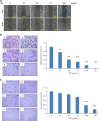Biodegradable interstitial release polymer loading a novel small molecule targeting Axl receptor tyrosine kinase and reducing brain tumour migration and invasion
- PMID: 26257061
- PMCID: PMC4855077
- DOI: 10.1038/onc.2015.277
Biodegradable interstitial release polymer loading a novel small molecule targeting Axl receptor tyrosine kinase and reducing brain tumour migration and invasion
Abstract
Glioblastoma multiforme (GBM) is the most common and aggressive brain tumour. The neoplasms are difficult to resect entirely because of their highly infiltration property and leading to the tumour edge is unclear. Gliadel wafer has been used as an intracerebral drug delivery system to eliminate the residual tumour. However, because of its local low concentration and short diffusion distance, patient survival improves non-significantly. Axl is an essential regulator in cancer metastasis and patient survival. In this study, we developed a controlled-release polyanhydride polymer loading a novel small molecule, n-butylidenephthalide (BP), which is not only increasing local drug concentration and extending its diffusion distance but also reducing tumour invasion, mediated by reducing Axl expression. First, we determined that BP inhibited the expression of Axl in a dose- and time-dependent manner and reduced the migratory and invasive capabilities of GBM cells. In addition, BP downregulated matrix metalloproteinase activity, which is involved in cancer cell invasion. Furthermore, we demonstrated that BP regulated Axl via the extracellular signal-regulated kinases pathway. Epithelial-to-mesenchymal transition (EMT) is related to epithelial cells in the invasive migratory mesenchymal cells that underlie cancer progression; we demonstrated that BP reduced the expression of EMT-related genes. Furthermore, we used the overexpression of Axl in GBM cells to prove that Axl is a crucial target in the inhibition of GBM EMT, migration and invasion. In an in vivo study, we demonstrated that BP inhibited tumour growth and suppressed Axl expression in a dose-dependent manner according to a subcutaneous tumour model. Most importantly, in an intracranial tumour model with BP wafer in situ treatment, we demonstrated that the BP wafer not only significantly increased the survival rate but also decreased Axl expression, and inhibited tumour invasion. These results contribute to the development of a BP wafer for a novel therapeutic strategy for treating GBM invasion and increasing survival in clinical subjects.
Figures









References
-
- Jelsma R, Bucy PC. The treatment of glioblastoma multiforme of the brain. J Neurosurg 1967; 27: 388–400. - PubMed
-
- Tsitlakidis A, Foroglou N, Venetis CA, Patsalas I, Hatzisotiriou A, Selviaridis P. Biopsy versus resection in the management of malignant gliomas: a systematic review and meta-analysis. J Neurosurg 2010; 112: 1020–1032. - PubMed
-
- Giese A, Bjerkvig R, Berens ME, Westphal M. Cost of migration: invasion of malignant gliomas and implications for treatment. J Clin Oncol 2003; 21: 1624–1636. - PubMed
-
- Blacklock JB, Wright DC, Dedrick RL, Blasberg RG, Lutz RJ, Doppman JL et al. Drug streaming during intra-arterial chemotherapy. J Neurosurg 1986; 64: 284–291. - PubMed
-
- Shapiro WR, Green SB. Reevaluating the efficacy of intra-arterial BCNU. J Neurosurg 1987; 66: 313–315. - PubMed
Publication types
MeSH terms
Substances
LinkOut - more resources
Full Text Sources
Other Literature Sources
Research Materials
Miscellaneous

